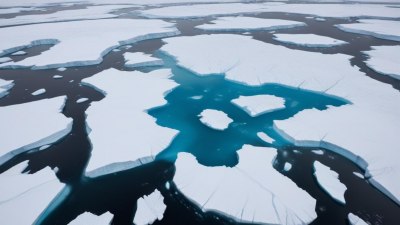How the Arctic and Antarctic Are Just Sibling Rivalries but in Ice Form
Explore the playful rivalry between the Arctic and Antarctic, delving into their unique features and environmental significance.

This image was created with the assistance of Freepik
The Earth is home to two polar regions that often evoke a sense of fascination and wonder: the Arctic and the Antarctic. While they may appear similar at first glance, each region has its unique characteristics, much like siblings in a family. It's intriguing to consider the differences and similarities between these two icy realms, both of which play critical roles in the planet's climate and ecology.
Geographical Differences
Geographically, the Arctic and Antarctic are situated at opposite ends of the planet. The Arctic is located at the northernmost part of the Earth, centered around the North Pole, and is primarily a sea surrounded by land. In contrast, the Antarctic is at the southernmost part, centered on the South Pole, and is a vast landmass covered by a thick ice sheet. This fundamental difference in geography gives rise to their distinct ecosystems and climatic conditions.
Climate and Weather Patterns
The climate in the Arctic tends to be milder than in the Antarctic, mainly due to the surrounding ocean currents that moderate temperatures. The Arctic experiences seasonal variations that allow for the melting of sea ice during the summer months. Conversely, the Antarctic remains colder throughout the year, with its interior spanning some of the coldest temperatures recorded on Earth. Winter temperatures in Antarctica can plummet to -80 degrees Celsius (-112 degrees Fahrenheit), demonstrating its dominance in the cold rivalry.
Ecosystems and Biodiversity
Each region showcases unique wildlife adapted to its specific environment. In the Arctic, animals like polar bears, seals, and various species of whales thrive in the icy waters and on the land. The presence of a more diverse range of habitats allows for a rich biodiversity, making it a vibrant ecosystem. On the other hand, the Antarctic is known for its penguins, particularly the Emperor Penguin, which has adapted to the harsh conditions. The lack of terrestrial mammals in Antarctica makes its ecological competition with the Arctic distinctly different, resembling a more solitary sibling.
The Ice Sheets and Climate Change
The vast ice sheets of both regions are critical indicators of climate change. The Antarctic Ice Sheet is the largest single mass of ice on Earth, containing about 60% of the world’s fresh water. Its stability is crucial for global sea levels. In contrast, the Arctic sea ice is disappearing at an alarming rate due to rising temperatures, influencing weather patterns far beyond its borders. This competition for stability and survival highlights the sibling-like rivalry between the two poles as they each contend with the impacts of climate change.
Research and Exploration
Scientific research in both polar regions has revealed much about our planet's climate and ecosystems, yet they are often viewed through different lenses. The Arctic has long been a site for exploration and indigenous habitation, with communities relying on its resources for centuries. Meanwhile, Antarctica is largely uninhabited except for research stations, governed by the Antarctic Treaty System, which promotes scientific exploration and conserves the region's ecology. This dichotomy mirrors sibling dynamics, where one may be deemed more adventurous while the other is seen as a more reserved scholar.
Human Impact and Conservation Efforts
Human activity has a profound impact on both the Arctic and Antarctic regions, contributing to their environmental challenges. In the Arctic, oil drilling, shipping, and fishing have raised concerns about the delicate balance of its ecosystem. The melting ice also opens new shipping routes, which, while economically beneficial, threaten local wildlife. In contrast, Antarctic waters are rigorously protected from overfishing, yet tourism is a growing concern, presenting challenges to its pristine conditions. Conservation efforts in both areas show how these sibling rivals share a common goal: to protect their unique environments amid pressures from the outside world.
Cultural Perspectives
The Arctic and Antarctic also hold different cultural significances. Indigenous cultures in the Arctic have deep connections to the land and sea, developed over generations of living in harmony with their environment. Their traditions, stories, and practices contribute to a rich cultural tapestry that acknowledges the land. In contrast, Antarctica, largely devoid of indigenous populations, serves as a blank canvas for scientific progress and exploration, often romanticized as the final frontier. This cultural rivalry echoes sibling relationships, where one may have deep roots while the other embodies aspirations and uncharted potential.
Future Outlook and Changes
Looking towards the future, both the Arctic and Antarctic face unprecedented changes. The Arctic is warming at a rate nearly twice as fast as the global average, leading to severe implications for weather patterns and ecosystems. Meanwhile, the stability of the Antarctic Ice Sheet is also under threat from climate change, with melting glaciers contributing significantly to rising sea levels. The sibling rivalry here underscores the idea that these two polar extremes are interconnected; changes in one affect the other, reminding us of the shared responsibility we have in addressing climate change.
In conclusion, the Arctic and Antarctic can be seen as sibling rivals, each with its unique characteristics, challenges, and roles within the Earth's climate system. The playful comparison of their differences and similarities reveals deeper insights into the environmental issues we face today. By understanding these polar regions not just as distant, isolated entities, but as integral parts of our planet's ecosystem, we can appreciate their importance and strive to protect both from the current climate crisis.











